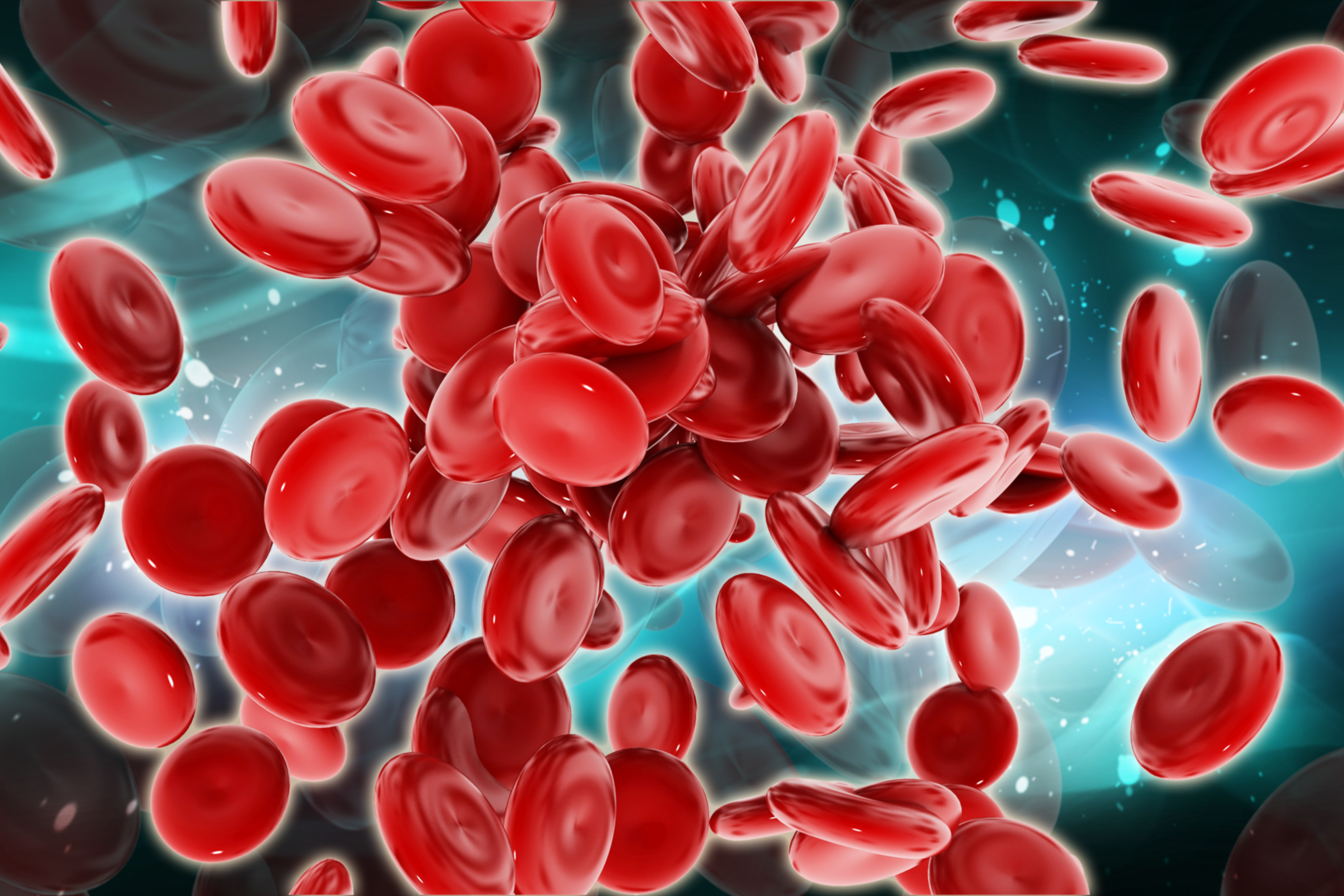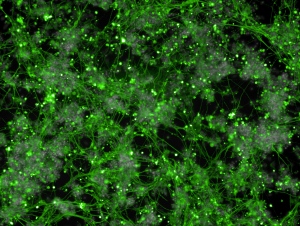It looks like you're using an Ad Blocker.
Please white-list or disable AboveTopSecret.com in your ad-blocking tool.
Thank you.
Some features of ATS will be disabled while you continue to use an ad-blocker.
12
share:

Canadian scientists have discovered how to turn a simple blood sample from a man or woman into a variety of nerve cells, including those that are responsible for pain, numbness and other sensations.
The technology will allow researchers to test potential drugs for treating pain using the nerve cells in a lab, all based on an individual patient's own genetic signature, said Mick Bhatia, who led the team of researchers at McMaster University in Hamilton.

A microscope image shows neurons (stained in order to be visible) derived from blood using the new method. (McMaster University)
The new technique involves extracting stem cells from blood — ones that normally have the potential to become red blood cells or various kinds of white blood cells involved in fighting off pathogens. The blood stem cells are converted over about a month into neural stem cells using a patented technique. Those can survive for several months in a petri dish.
These neural stem cells are then manipulated in the lab to give rise to several types of nerve cells, including those that make up the peripheral nervous system throughout the arms, legs and the rest of the body.
His lab hopes to further develop the blood-generated neural stem cells into motor and other kinds of neurons that could conceivably one day be transplanted into patients to restore healthy brain cells as a treatment for Alzheimer's, Parkinson's or Lou Gehrig's disease, for instance.
The technology could also be used to produce retinal nerve cells to treat people who are losing their sight due to age-related macular degeneration, he said.
Amazing !
I am curious to see what this can do for people for are paralyzed ? The future looks promising in this field.
Your thoughts ?
you can also read more HERE
Kap.
That sounds an awful lot like genetic modification.
Isn't that bad and dangerous and stuff? What if the blood cells take over?
Sorry. Long weekend. Monday afternoon.
Actually very fascinating and encouraging research.
Isn't that bad and dangerous and stuff? What if the blood cells take over?
Sorry. Long weekend. Monday afternoon.
Actually very fascinating and encouraging research.
Not necessarily genetic manipulation.Stem cells have the ability to become any type of cells including any form of neuron. This is the major reason so
much has been put into stem cell research and specialists have been fighting the ban on this research. This could be the answer to genetic defects ,
macular degeneration , diabetes, etc.
a reply to: anonentity
No they weren't.
They were produced as red blood cells.
No they weren't.
They were produced as red blood cells.
edit on 5/25/2015 by Phage because: (no reason given)
originally posted by: Phage
a reply to: anonentity
No they weren't.
They were produced as red blood cells.
At one stage they were so immature, as to be indistinguishable, from stem cells. Like the human foetus was at one stage indistinguishable from a fish.
a reply to: anonentity
Actually, the article is about turning hemocytoblasts into nerve cells.
No. Hemocytoblasts are not much like stem cells, they can only form blood cells.
At one stage they were so immature, as to be indistinguishable, from stem cells.
Actually, the article is about turning hemocytoblasts into nerve cells.
edit on 5/25/2015 by Phage because: (no reason given)
originally posted by: anonentity
originally posted by: Phage
a reply to: anonentity
No they weren't.
They were produced as red blood cells.
At one stage they were so immature, as to be indistinguishable, from stem cells. Like the human foetus was at one stage indistinguishable from a fish.
I agree. Both are very easy to distinguish from each other. Human Foetus never looks just like a fish. Ontogeny recapitulates phylogeny is an unscientific falsehood.
I read this article last week but couldn't quite understand it. I was under the impression that blood cells did not have DNA like our body cells do.
Maybe there is a stem cell in it though or just RNA. Every fat cell has a stem cell from what I have read. The nerve cells need to match our DNA to
communicate right or there will be rejection.
Maybe I'll just have to hunt down the whole research article to see what it says.
Maybe I'll just have to hunt down the whole research article to see what it says.
edit on 26-5-2015 by rickymouse because: (no reason
given)
a reply to: rickymouse
Mature Red Blood cells do not. Hemocytoblasts are not mature yet and I believe they do.
Mature Red Blood cells do not. Hemocytoblasts are not mature yet and I believe they do.
originally posted by: OccamsRazor04
originally posted by: anonentity
originally posted by: Phage
a reply to: anonentity
No they weren't.
They were produced as red blood cells.
At one stage they were so immature, as to be indistinguishable, from stem cells. Like the human foetus was at one stage indistinguishable from a fish.
I agree. Both are very easy to distinguish from each other. Human Foetus never looks just like a fish. Ontogeny recapitulates phylogeny is an unscientific falsehood.
So you maintain that the human foetus during its development hasn't got gills.?
/setswatch
How long do you surmise, til this discovery's demise? Tick- tock, tick-tock...
How long do you surmise, til this discovery's demise? Tick- tock, tick-tock...
originally posted by: anonentity
originally posted by: OccamsRazor04
originally posted by: anonentity
originally posted by: Phage
a reply to: anonentity
No they weren't.
They were produced as red blood cells.
At one stage they were so immature, as to be indistinguishable, from stem cells. Like the human foetus was at one stage indistinguishable from a fish.
I agree. Both are very easy to distinguish from each other. Human Foetus never looks just like a fish. Ontogeny recapitulates phylogeny is an unscientific falsehood.
So you maintain that the human foetus during its development hasn't got gills.?
Hahahahahahaha. Gills. No one thinks they have gills.
human fetuses have pharyngeal or branchial pouches that are sometimes called gill slits. They are transitory structures that eventually become parts of the jaw and the upper respiratory tract and they do not function like gills at all.
courses.bio.indiana.edu...
Phenotype does not equal genotype.
edit on 27-5-2015 by OccamsRazor04 because: (no reason given)
originally posted by: rickymouse
I read this article last week but couldn't quite understand it. I was under the impression that blood cells did not have DNA like our body cells do. Maybe there is a stem cell in it though or just RNA. Every fat cell has a stem cell from what I have read. The nerve cells need to match our DNA to communicate right or there will be rejection.
Maybe I'll just have to hunt down the whole research article to see what it says.
When undifferentiated stem cells mature into Red Blood Cells, they lose their Nuclei, thus lose their DNA. However, when the cells is still immature and undifferentiated, it stills contain it's DNA.
In regards to your statement concerning rejection, I believe this technique would be utilizing the stem cells from the same person who will be on the receiving end, thus will not need to worry about rejection.
new topics
-
Planned Civil War In Britain May Be Triggered Soon
Social Issues and Civil Unrest: 35 minutes ago -
Claim: General Mark Milley Approved Heat and Sound Directed Energy Weapons During 2020 Riots
Whistle Blowers and Leaked Documents: 2 hours ago
top topics
-
Claim: General Mark Milley Approved Heat and Sound Directed Energy Weapons During 2020 Riots
Whistle Blowers and Leaked Documents: 2 hours ago, 3 flags -
Planned Civil War In Britain May Be Triggered Soon
Social Issues and Civil Unrest: 35 minutes ago, 1 flags
active topics
-
Gravitic Propulsion--What IF the US and China Really Have it?
General Conspiracies • 26 • : fringeofthefringe -
Ukraine halts transit of Russian gas to Europe after a prewar deal expired
Political Conspiracies • 146 • : xuenchen -
Claim: General Mark Milley Approved Heat and Sound Directed Energy Weapons During 2020 Riots
Whistle Blowers and Leaked Documents • 8 • : rickymouse -
Sorry to disappoint you but...
US Political Madness • 37 • : matafuchs -
The Truth about Migrant Crime in Britain.
Social Issues and Civil Unrest • 24 • : angelchemuel -
Trudeau Resigns! Breaking
Mainstream News • 69 • : KrustyKrab -
Planned Civil War In Britain May Be Triggered Soon
Social Issues and Civil Unrest • 0 • : TimBurr -
Stuck Farmer And His Queue Jumping Spawn
Rant • 10 • : Cvastar -
Joe Biden gives the USA's Highest Civilian Honor Award to Hillary Clinton and George Soros.
US Political Madness • 59 • : mysterioustranger -
Greatest thing you ever got, or bought?
General Chit Chat • 24 • : mysterioustranger
12
